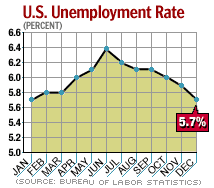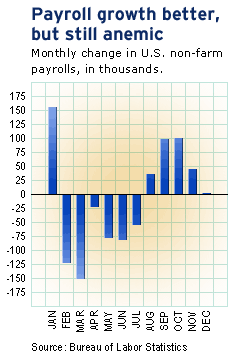NEW YORK (CNN/Money) -
Friday could be the day economists, politicians and the unemployed get the good news about the job market they've long been awaiting -- although the numbers may not be entirely trustworthy.
The Labor Department is scheduled to report on January's unemployment rate and job growth Friday morning, and the consensus view of economists is the report will be one of the best in years.

Economists, on average, expect unemployment to hold steady at 5.7 percent and payrolls to grow by 165,000 jobs outside the farm sector, according to Briefing.com. Such payroll growth would be the strongest since November 2000.
It could also justify the belief among many economists that the payroll figure -- the job-market measure most closely watched by Wall Street -- is finally catching up with stronger growth in the rest of the economy and with other hints of a job-market recovery.
"We're seeing signs in other reports and in our analysis of various industries suggesting that hiring did in fact perk up substantially in January," said Parul Jain, deputy chief economist at Nomura Securities, which expects payroll growth of 195,000 jobs.
| Related stories
|

|
|
|
|
Many economists also think seasonal quirks could juice up January's data. Ordinarily, retailers hire extra workers in the last quarter for the holiday shopping season, and the Labor Department adjusts its numbers to discount that extra hiring. But retail hiring was weak in 2003, which possibly made payroll numbers for the holiday months look weaker.
The upside of this is that January's data, which are seasonally adjusted to anticipate big retail layoffs, could look better than they really were since there weren't any excess retail workers to lay off this season.
"Retail hiring between October and December was by far the smallest in years," said Russell Sheldon, senior economist at BMO Nesbitt Burns. "We wonder if those 'not hired' for Christmas will 'not be let go,' as traditionally would happen, in January. If so, that will look like a gain in the seasonally adjusted numbers."
Payroll data out of sync?
Some other indicators pointing to a stronger payroll number on Friday include:
- a fairly sharp decline recently in the number of new weekly claims for unemployment insurance
- a bounce in hiring intentions in the Institute for Supply Management's monthly surveys of manufacturing and service-sector purchasing managers
- a jump in hiring intentions in the National Federation of Independent Business' monthly surveys of small businesses

What's more, the Labor Department's monthly employment report, generated by a survey of households, has oddly been much stronger in recent months than the payroll report, which is generated by a survey of employers.
Economists believe the payroll report is more credible, since it draws from a wider sample, but many also acknowledge it could miss jobs being created in new start-up companies early in economic recoveries.
Revisions to last year's data, which will come Friday when the Labor Department applies new benchmarks, could make up some of the difference between the household and payroll surveys, but many economists doubt it will totally close the gap.
"We do not expect significant revisions to recent months, but some upward adjustments [to payroll numbers] seem more likely than downward adjustments," UBS economists said in a research note Thursday.
Trouble with numbers
Unfortunately, while seasonal quirks and benchmark revisions could boost payroll data, they could also make it hard to crunch the numbers. They've already been a headache for economists trying to make forecasts.
"Benchmark revisions could completely recast underlying data, in which case January forecasts won't be useful," said Steven Wieting, senior economist at Citigroup, which expects a whopping 300,000 new jobs in January.
Wieting warned against placing too much importance Friday's number, given the quirkiness of the data -- a very strong report may not mean the labor market is set for a full recovery, while a very weak report may not mean the end of the world.
"Years from now, new benchmark revisions will come along and change the whole picture again -- which begs the question of how important these monthly payroll changes are," Wieting said. "I think it's irresponsible to make too much of these reports."
Ironically, that's just what many politicians, consumers and traders on Wall Street will probably do. Friday's report is expected by many on Wall Street to help settle the debate about whether the job market is finally rebounding or is in the midst of structural changes that will keep hiring weaker than usual.
The Federal Reserve, however, will likely not be swayed one way or the other by the report. Most economists believe it will need to see strong payroll gains for several straight months before it's likely to start raising interest rates.
Signs of lingering weakness
Some economists aren't sure the job market is skyrocketing yet and worry that lingering business caution, technological advances that let firms keep payrolls lean, and a trend toward overseas outsourcing could conspire against strong hiring.
That view seems to be shared by some consumers; in the Conference Board's monthly consumer confidence survey, the percentage of consumers saying jobs are "hard to get" has been above 30 for 10 out of the past 12 months, the longest such stretch since 1993-94.
And the Federal Reserve's latest "Beige Book" report, which compiles anecdotal evidence about the economy's health, saw only "modest improvements in labor markets," with "minimal" hiring in much of the country and many workers still "easy to recruit."
"The sentiment I get from the Beige Book, along with listening to quarterly earnings conference calls, and just the general tone of my conversations with people who have their fingers on the trigger of hiring, say companies are just not doing much of it," said Richard Yamarone, chief economist at Argus Research.
And several labor-market professionals seem to agree.
Tom Silveri, president of human resources consulting firm DBM, said this week that "hiring will most likely prove a slow and steady process in 2004." John Challenger, CEO of outplacement firm Challenger, Gray & Christmas, has been predicting the next job "boom" won't come until 2008.
On Wednesday, Jeffrey Joerres, CEO of staffing firm Manpower Inc. (MAN: Research, Estimates), told the Financial Times he didn't expect global hiring to pick up until the second quarter.
"We've got the spinnaker up, but the sail is sort of flapping at the moment," Joerres reportedly said.

|

